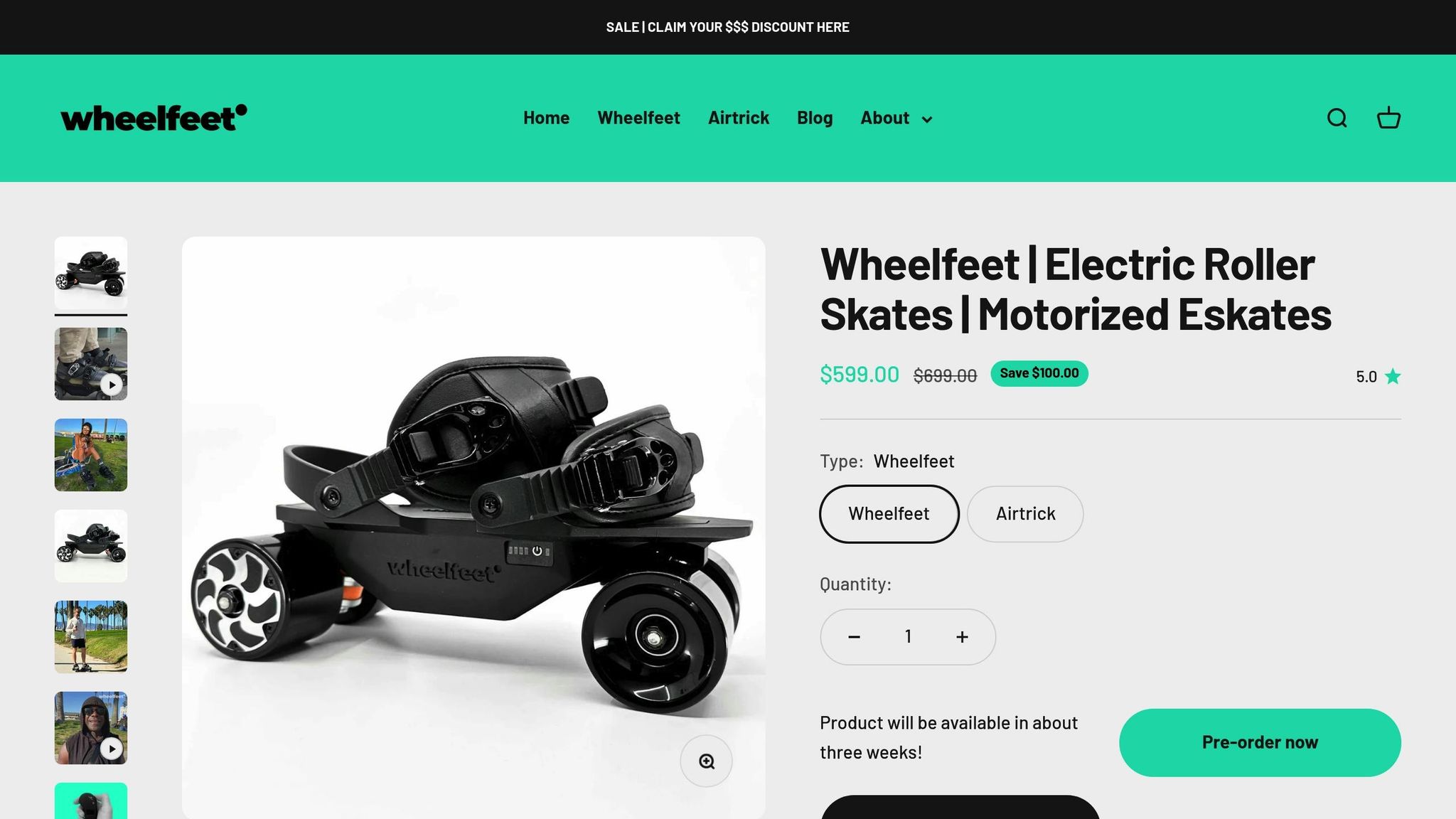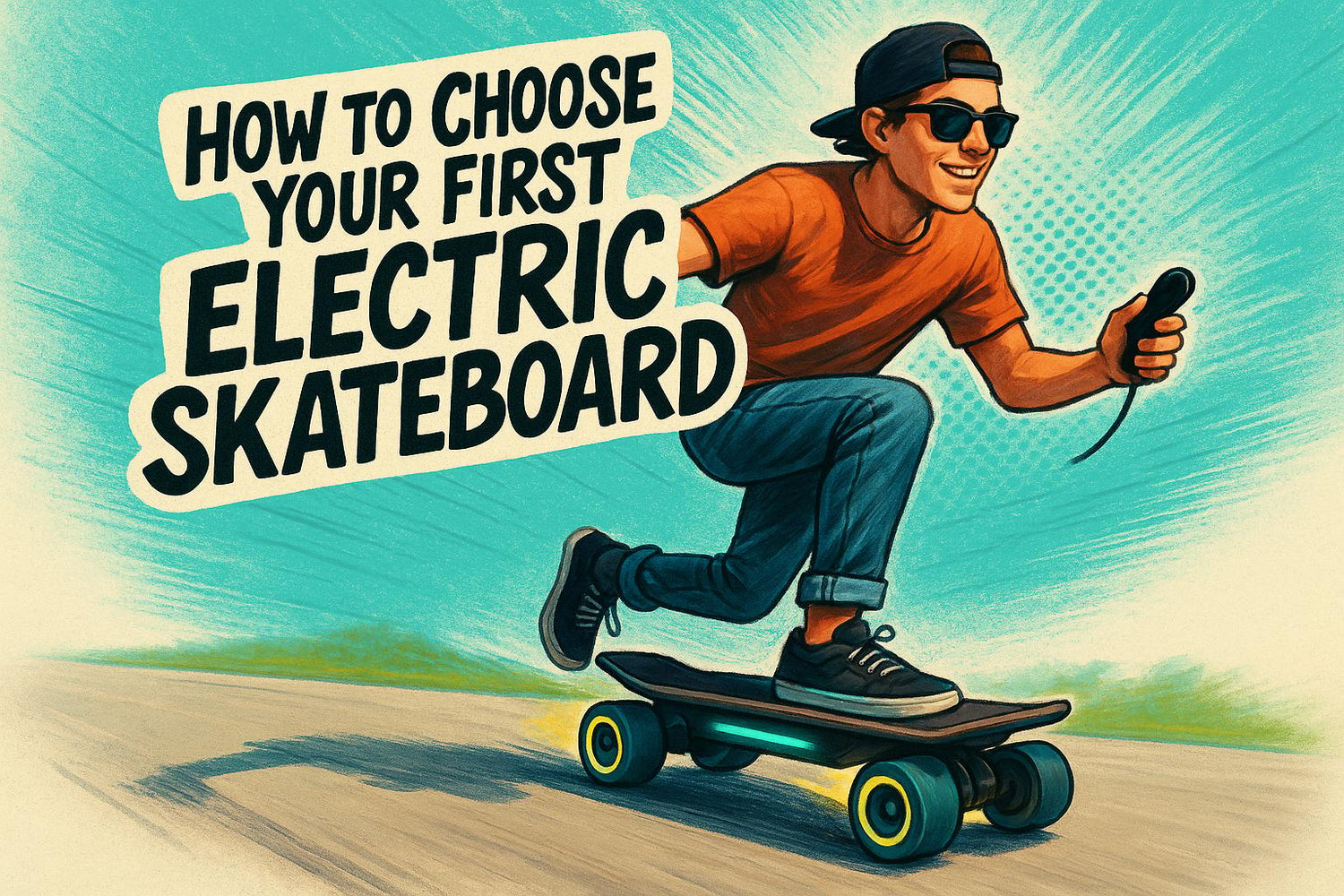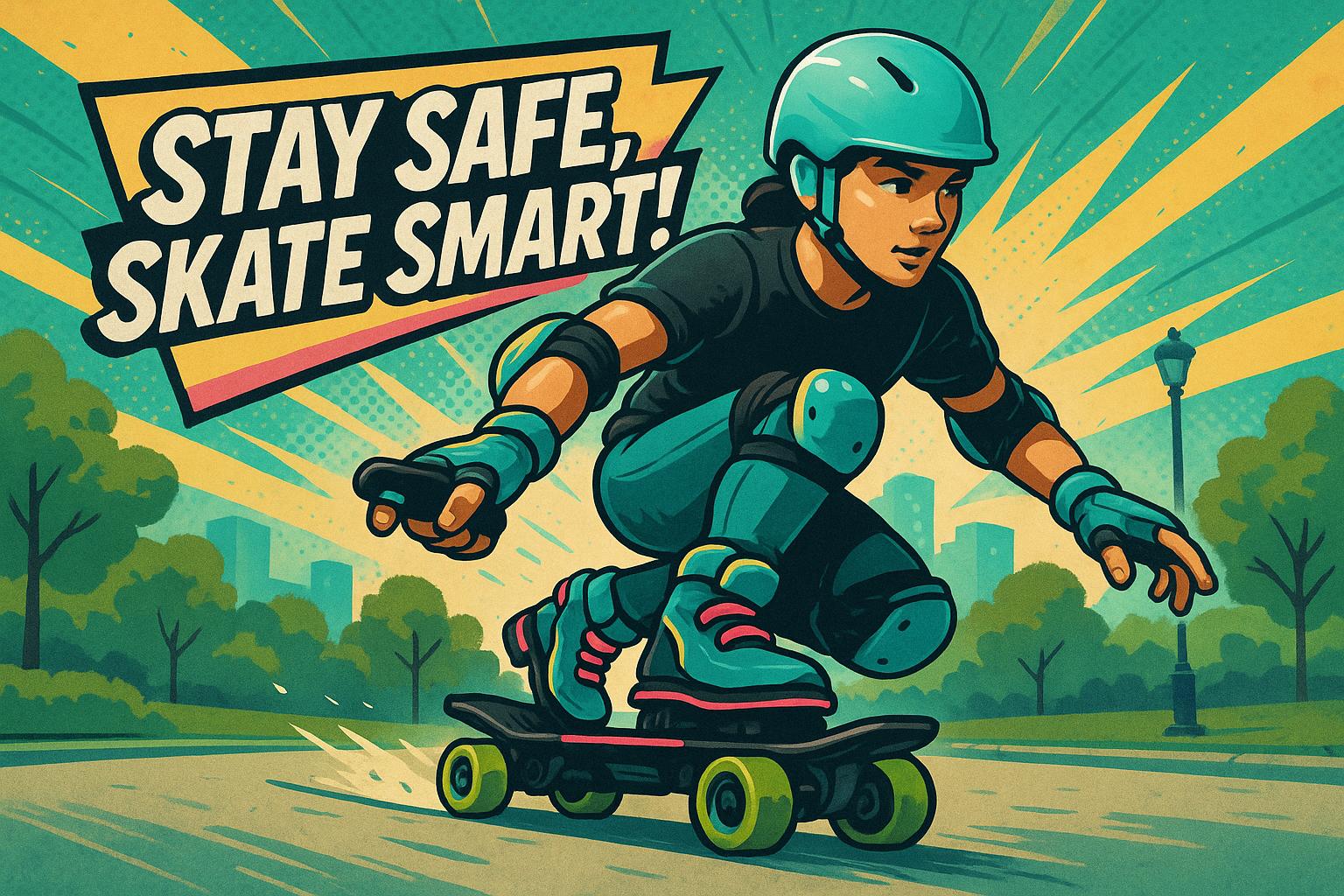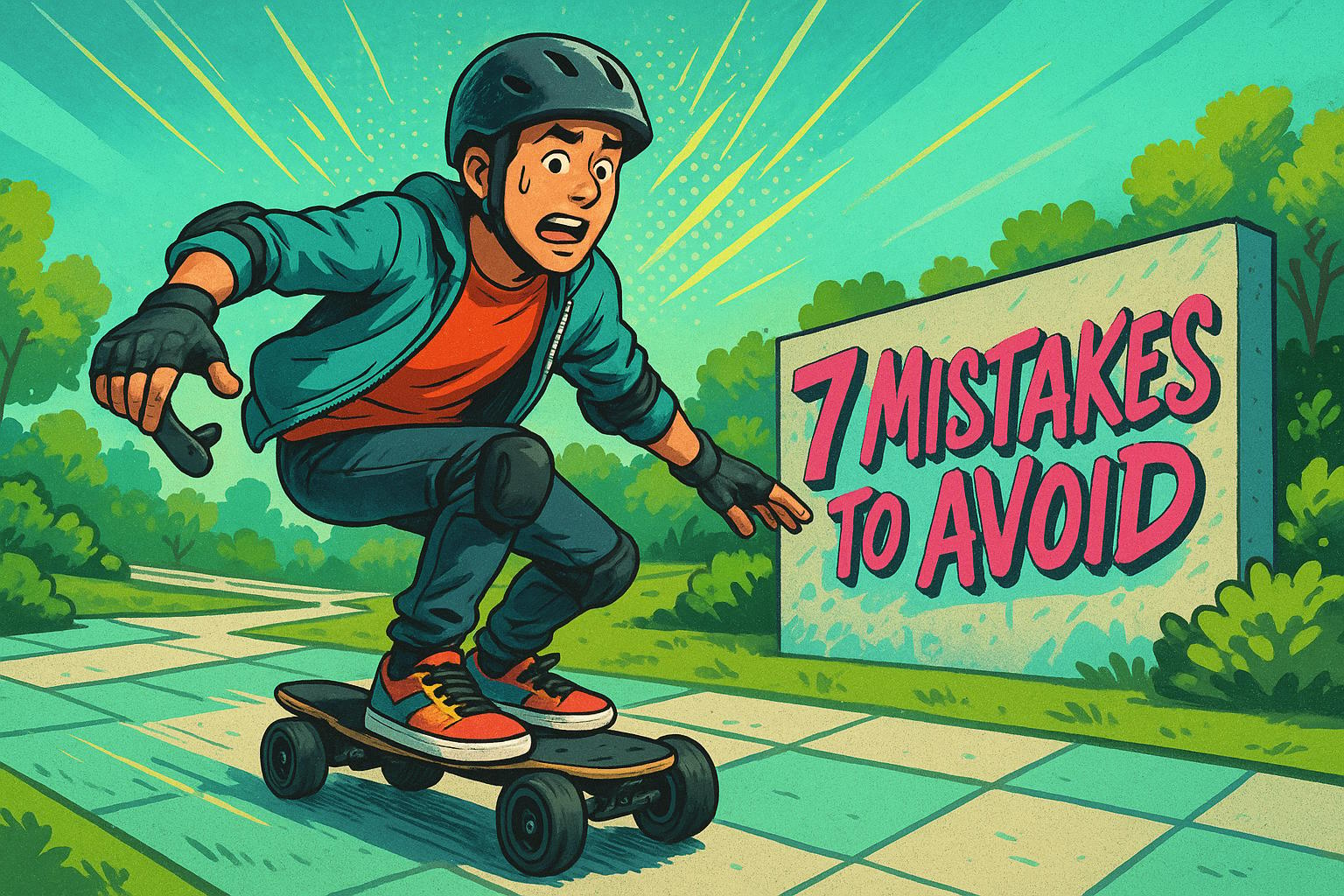Electric skateboards are an easy, fun, and eco-friendly way to get around. Whether you're commuting, riding across campus, or just cruising, picking the right board comes down to your budget, needs, and skill level. Here's what you need to know:
- Budget: Entry-level boards ($300–$600) are great for beginners, while mid-range models ($600–$1,200) offer better performance and durability.
- Range & Speed: Entry-level boards typically cover 6–10 miles at 12–18 mph, while mid-range boards can go 12–20 miles at up to 25 mph.
- Features: Beginners should look for stability, beginner-friendly modes, and reliable braking. Mid-range boards add dual motors, better materials, and smartphone app controls.
- Portability: Weight matters. Lighter boards (<13 lbs) are easier to carry, but heavier ones (>17 lbs) pack more power and range.
- Terrain: Larger, softer wheels handle bumps and cracks better. If you're riding hills or rough paths, opt for a board with stronger motors and durable construction.
- Safety: Look for multiple speed settings, regenerative braking, and water resistance (IP55 or better).
For beginners, models like the Wheelfeet Electric Roller Skates ($599) offer a balanced mix of performance and ease of use. They weigh just 8.8 lbs, have a 9-mile range, and feature dual-mode functionality (electric/manual).
Key Takeaway: Start with a board that matches your budget and riding needs. Prioritize safety, stability, and ease of use as you build confidence.
How To Choose The Best Electric Skateboard For Beginners
Setting Your Budget and Price Ranges
Before diving into the world of electric skateboards, it’s smart to set a clear budget. Your budget will help narrow down your options and ensure you find a board that meets your needs without overpaying for features you might not use - especially if you’re just starting out. While spending more often means better reliability, longer battery life, and added safety, beginners can usually skip the high-end bells and whistles.
Think about how you’ll use your board. If it’s for short rides around the neighborhood or campus, a basic model will do the trick. But if you’re commuting daily or planning longer trips, it’s worth investing in a board with extended battery range and sturdier construction.
Here’s a breakdown of what you can expect at different price points:
Entry-Level Boards ($300–$600)
Entry-level boards are perfect for beginners who want to test the waters without spending a fortune. These boards usually come with single motor systems, which are great for flat surfaces and mild inclines but might struggle on steeper hills.
- Battery range: Typically 6–10 miles per charge, making them ideal for short rides or casual commutes. Charging takes about 2–4 hours.
- Top speeds: Generally between 12–18 mph, a manageable range for beginners learning to balance and build confidence.
- Deck materials: Often made from maple or composite materials. While not as durable as premium options, they’re sturdy enough for light use and learning.
- Weight: These boards tend to be on the heavier side, usually 11–15 pounds, which affects portability but doesn’t significantly impact ride quality.
- Remote controls: Simple and user-friendly, with basic acceleration and braking functions. Many include beginner modes to limit speed while you’re still getting the hang of things.
- Braking systems: Regenerative braking is common, giving a slight battery boost while slowing down.
The main trade-offs at this price range include shorter battery life, less powerful motors, and simpler construction. However, these boards still deliver the core electric skateboarding experience and are a great way to see if the hobby fits your lifestyle before committing to a pricier model.
Mid-Range Boards ($600–$1,200)
Mid-range boards strike a balance between performance and affordability, offering a noticeable step up in features and build quality. Many models in this range come with dual motor systems, which provide better acceleration, improved stability, and the ability to handle hills more effectively.
- Battery performance: You’ll see a significant upgrade here, with ranges extending to 12–20 miles per charge. These boards often use higher-quality batteries that maintain their capacity longer. Some models even offer fast-charging options, cutting charging times to under 2 hours.
- Top speeds: Most mid-range boards can hit 20–25 mph, with advanced speed control systems and multiple riding modes, such as eco settings for longer rides or performance modes for speed enthusiasts.
- Deck materials: Expect bamboo, carbon fiber, or high-grade composites. These materials offer better flexibility, durability, and often reduce weight, even with more powerful components. Board weights typically range from 13–17 pounds.
- Advanced features: Many boards in this category come with smartphone apps for customization, GPS tracking, and ride stats. Remote controls also get an upgrade, featuring LCD displays for speed and battery life, along with more precise control over acceleration and braking.
- Braking systems: A mix of regenerative and mechanical braking provides smoother and more responsive stopping power, which is especially important at higher speeds.
- Water resistance: Improved protection, with many boards offering IPX4 ratings or better, allowing them to handle light rain or splashes.
Mid-range boards are also more versatile when it comes to terrain. While entry-level boards are best on smooth pavement, these can handle rougher surfaces, moderate hills, and varied urban landscapes. They typically manage hill grades of 15–20%, depending on the rider’s weight, making them a solid choice for both city streets and suburban paths.
Choosing Features Based on Your Experience and Riding Needs
When selecting a skateboard, it’s essential to match its features to your skill level and intended use. Beginners should prioritize stability, while experienced skaters can opt for boards with more responsive controls.
If you're just starting out, focus on features that make the board forgiving and easy to ride. Think about how you’ll use it - commuting, casual cruising, or something else. Your terrain also plays a role: smooth surfaces like bike paths require different features than bumpy sidewalks.
As mentioned earlier, beginners benefit from boards that help build confidence with steady, predictable handling. Experienced riders, on the other hand, can explore more advanced options that offer greater responsiveness and performance.
Let’s break down the key dimensions and features that directly impact the board’s stability and responsiveness.
Board Size and Stability
Deck length is one of the first things to consider. Generally, longer boards are more stable, which makes them ideal for beginners. Boards in the 35–40 inch range strike a good balance between stability and maneuverability for new riders. Shorter boards, around 28–32 inches, are more portable and agile but demand better balance and precise foot placement to maintain stability.
Deck width is equally important. Wider decks (8.5–10 inches) provide more space for your feet, making them feel steadier - especially when accelerating or braking. Narrower decks, while better suited for experienced riders who value agility, can feel less forgiving for those still mastering their balance.
Deck flexibility also plays a role in how the board handles. Stiffer decks are better for beginners because they offer more direct control and stability, making the ride feel predictable. Flexible decks, while great at absorbing road vibrations and providing a surf-like feel, require more skill to manage effectively.
Wheel size and hardness (measured as durometer) significantly affect ride quality and terrain adaptability. Larger wheels (90–110mm) handle cracks and bumps better, offering a smoother ride on uneven terrain. Smaller wheels (70–85mm) accelerate faster and feel more responsive but can transmit more vibrations. Softer wheels (78A–85A durometer) grip the surface better and absorb shocks, making them ideal for rougher paths. Harder wheels (85A–95A) are faster but less forgiving on bumpy roads.
For beginners sticking to sidewalks and bike paths, 90–100mm wheels with an 80A–85A durometer offer a great mix of comfort and control. If you’re riding on smooth surfaces like parking lots or freshly paved roads, smaller, harder wheels might be a better fit for faster acceleration.
Truck design determines how easily the board turns and how stable it feels. Looser trucks allow for sharper turns but can feel wobbly, while tighter trucks provide better stability but require more effort to turn. Most electric skateboards come with pre-adjusted trucks, but being able to tweak them lets you adapt as your skills improve.
Weight and Portability
Weight is a crucial factor, especially if you’ll frequently carry your skateboard. The difference between a 12-pound and an 18-pound board might not seem like much, but you’ll feel it when climbing stairs or navigating crowded spaces.
For commuters, ultra-portable boards (under 13 pounds) are a great option. They often sacrifice some battery life or motor power to achieve a lighter weight, but the convenience is worth it for many. These boards typically use materials like carbon fiber and smaller batteries to stay lightweight.
Standard weight boards (13–17 pounds) balance portability and performance, making them a popular choice for most riders. They’re manageable to carry short distances and offer decent battery life and motor power. Most mid-range boards fall into this category.
Heavy-duty boards (over 17 pounds) prioritize performance, with larger batteries and more powerful motors. They’re perfect for riders focused on longer trips without much carrying. However, they can be cumbersome if your commute involves stairs or public transit.
Your carrying method also matters. Some boards include built-in handles or straps that make transport easier, even for heavier models. Others are designed with sleek profiles that fit comfortably under your arm. If portability is a priority, ensure the board is easy to grip and carry in real-world situations.
Storage needs can also influence your decision. Heavier boards with bigger batteries take up more space and may require sturdier storage solutions. If you live in a small apartment or need to store your board in a compact space, lighter options are more practical.
Finally, consider how your own weight and physical strength factor into portability. For example, an 18-pound board will feel much heavier to someone weighing 110 pounds compared to someone weighing 180 pounds. Think about your personal comfort and any physical limitations when weighing portability against performance.
With these basics in mind, we can now dive into performance features that further enhance your riding experience.
Performance Specs: Motor Power and Drive Systems
The motor's power plays a key role in both acceleration and top speed. For those just starting out, motors in the range of 500W to 1,500W are often ideal. These provide enough power for quick takeoffs, climbing hills, and keeping a steady pace across different types of terrain.
The type of motor also impacts performance. Hub motors are a popular choice for beginners because they are simple, run quietly, and need less upkeep. On the other hand, belt-driven systems are designed to tackle steeper hills and rougher terrain with their higher torque, though they come with the trade-off of requiring more maintenance.
sbb-itb-bf837b9
Terrain, Safety, and Build Quality
Water Resistance and Durability
Water resistance plays a key role in protecting critical components - like the battery, motor, and controller - from water damage. This not only extends the board's lifespan but also helps cut down on repair expenses.
For urban commuting or city rides, an IP55 rating is common. This level of protection guards against dust and light splashes, making it safe to ride through puddles or light drizzle. However, keep in mind that most electric skateboards are water-resistant, not fully waterproof. Heavy rain, deep water, or snow can still pose risks and should be avoided.
Being familiar with water resistance ratings helps you assess the board's build quality and ensures safer rides across different terrains.
Top Beginner Electric Skateboard Models
Building on the performance and safety specs mentioned earlier, let's explore a top beginner model that balances affordability with essential features.
Model Comparison Chart
Choosing the right beginner electric skateboard often means finding the sweet spot between features, performance, and price. Many first-time buyers either spend too much or too little, but a good starting range typically falls between $350 and $800.
| Model | Price | Range | Top Speed | Weight | Motor Type | Key Features |
|---|---|---|---|---|---|---|
| Wheelfeet Electric Roller Skates | $599 | 9 miles | 15 mph | 8.8 lbs | Dual hub motors | Regenerative braking, wireless remote, dual-mode versatility |
Now, let’s dive into what makes the Wheelfeet Electric Roller Skates a standout choice for beginners.
Wheelfeet Electric Roller Skates: Features and Benefits

The Wheelfeet Electric Roller Skates are designed with urban commuters in mind, offering a great mix of convenience and performance for those new to electric skating. Priced at $599, these skates sit comfortably in the beginner-friendly price range.
Equipped with a dual hub motor system, the skates can reach speeds of up to 15 mph and cover a range of 9 miles on a single charge. This makes them ideal for shorter city trips without overwhelming new riders. Plus, the regenerative braking system ensures smooth, reliable stops while extending the battery life.
One of the most appealing features is their portability. Weighing just 8.8 lbs, the skates are easy to carry onto public transportation or into buildings, making them a practical option for daily commutes.
The wireless remote control gives you precise control over speed and braking, and the adjustable speed settings allow beginners to gradually increase their confidence and skills.
Another standout feature is the dual-mode functionality, which allows you to switch between electric and manual skating. This ensures you’re never stranded if the battery runs low. Built with a durable aluminum frame, these skates are designed to handle the wear and tear of everyday use while offering a sustainable, eco-friendly alternative for urban travel.
Available in sizes that fit US shoe sizes 6–13, the Wheelfeet Electric Roller Skates provide a versatile and innovative way to navigate city streets. Whether you're commuting to work or exploring your neighborhood, they offer a fun and practical solution for getting around.
Making Your Final Decision
Choosing your first electric skateboard is all about balancing your budget, skill level, terrain needs, and the features that matter most to you. Start by setting a realistic budget - somewhere between $350 and $800. This range typically covers solid beginner boards without unnecessary extras.
Next, think about your experience level. If you're new to skating, focus on boards that offer stability, like those with wider decks and dependable braking systems. If you're more experienced, you might look for boards with higher speeds or advanced motor setups to match your skills.
Terrain plays a big role in how much you'll enjoy your board. For city commuters, boards that handle smooth pavement and gentle inclines are ideal. However, if your routes include rougher surfaces, you'll want larger wheels and more powerful motors. Keep in mind that most beginner boards are designed to perform best on smooth, paved roads.
When comparing models, don’t get too caught up in flashy specs. Real-world performance is what counts. For instance, a board with a reliable 9-mile range may be a smarter choice than one boasting 15 miles under perfect conditions. Similarly, smooth acceleration and responsive braking are far more valuable for beginners than top speeds.
Safety should be a top priority, no matter your budget. Look for features like multiple speed settings, high-quality materials, and effective braking systems. These details ensure a safer, more enjoyable ride.
Take the Wheelfeet Electric Roller Skates as an example. Priced at $599, they’re portable, offer a 15 mph top speed, and deliver a dependable 9-mile range. Plus, their dual-mode design lets you switch to manual skating if the battery dies, so you’re never left stranded.
Portability is another factor that’s easy to overlook but can make a big difference. If you’ll be carrying your board onto public transport, into buildings, or up stairs, consider its weight and size. A compact board that fits under a desk or in a locker can save you a lot of hassle.
Whenever possible, test ride the board or buy from a retailer with a flexible return policy. What looks perfect on paper might not feel right when you’re actually riding, and having the option to exchange it is invaluable.
Your first electric skateboard should be a reliable partner as you build your skills. Focus on quality construction, features that match your riding needs, and performance that feels right for you. Avoid chasing the cheapest or most advanced option - go for a board that supports your growth and keeps you safe from day one.
FAQs
What should I consider when setting a budget for my first electric skateboard?
When setting a budget for your first electric skateboard, it's crucial to strike a balance between cost and quality. In the U.S., beginner boards usually fall in the $150 to $299 range. However, if you can stretch your budget to around $600, you'll often find options with better durability, smoother rides, and features tailored for beginners.
Think about what you need: How far will you commute? What kind of terrain will you tackle? How often do you plan to ride? Spending a bit more upfront can make a big difference in safety and overall enjoyment, particularly if you're new to electric skateboards.
How does the terrain I’ll be riding on influence my choice of an electric skateboard?
The type of terrain you’ll be riding on is a key factor when picking the right electric skateboard. For hilly areas or uneven surfaces, opt for boards with high motor power, strong torque, larger wheels, and suspension systems to handle inclines and bumps with ease. If your adventures take you onto dirt paths, gravel, or off-road trails, an all-terrain skateboard is your best bet. These boards are built with durable motors and shock absorption features, offering better stability and performance on rougher ground.
If your rides will mostly stick to smooth city streets or sidewalks, a street skateboard is a better fit. These boards are lighter, easier to maneuver, and don’t require as much motor power. Choosing a board suited to your usual terrain not only makes your rides more enjoyable but also keeps them safer.
What safety features should I look for in an electric skateboard as a beginner?
As a beginner, safety should always come first when picking an electric skateboard. Opt for models equipped with dependable braking systems, such as regenerative or electronic brakes. These systems allow for smoother and more controlled stops, which is crucial when you're just starting out. A sturdy deck paired with quality grip tape also plays a big role in keeping you stable while riding.
Don't forget about protective gear - it’s non-negotiable. A certified helmet, along with knee pads, elbow pads, and gloves, can significantly reduce the chance of injury. Stick to slower speeds and choose smooth, predictable surfaces as you get the hang of things. By focusing on safety features and practicing smart riding habits, you'll set yourself up for a fun and secure experience.




Leave a comment
All comments are moderated before being published.
This site is protected by hCaptcha and the hCaptcha Privacy Policy and Terms of Service apply.